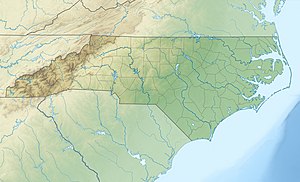Nick Creek (Rocky River tributary)
Appearance
| Nick Creek Tributary to Rocky River | |
|---|---|
| Location | |
| Country | United States |
| State | North Carolina |
| County | Chatham |
| Physical characteristics | |
| Source | Nick Creek divide |
| • location | pond about 2 miles southeast of Crutchfield Crossroads, North Carolina |
| • coordinates | 35°47′36″N 079°24′22″W / 35.79333°N 79.40611°W[1] |
| • elevation | 648 ft (198 m)[2] |
| Mouth | Rocky River |
• location | about 2.5 miles northeast of Siler City, North Carolina |
• coordinates | 35°45′40″N 079°26′00″W / 35.76111°N 79.43333°W[1] |
• elevation | 505 ft (154 m)[2] |
| Length | 3.81 mi (6.13 km)[3] |
| Basin size | 5.12 square miles (13.3 km2)[4] |
| Discharge | |
| • location | Rocky River |
| • average | 6.82 cu ft/s (0.193 m3/s) at mouth with Rocky River[4] |
| Basin features | |
| Progression | Rocky River → Deep River → Cape Fear River → Atlantic Ocean |
| River system | Deep River |
| Tributaries | |
| • left | unnamed tributaries |
| • right | unnamed tributaries |
| Bridges | Silk Hope-Liberty Road, Joe Fox Road, Jesse Bridges Road |
Nick Creek is a 3.81 mi (6.13 km) long 2nd order tributary to the Rocky River in Chatham County, North Carolina.
Course[edit]
Nick Creek rises in a pond about 2 miles southeast of Crutchfield Crossroads, North Carolina in Chatham County and then flows southwest to join the Rocky River about 2.5 miles northeast of Siler City.[2]
Watershed[edit]
Nick Creek drains 5.12 square miles (13.3 km2) of area, receives about 47.9 in/year of precipitation, has a wetness index of 440.45 and is about 45% forested.[4]
References[edit]
- ^ a b "GNIS Detail - Nick Creek". geonames.usgs.gov. US Geological Survey. Retrieved 2 September 2020.
- ^ a b c "Nick Creek Topo Map in Chatham". TopoZone. Locality, LLC. Retrieved 2 September 2020.
- ^ "ArcGIS Web Application". epa.maps.arcgis.com. US EPA. Retrieved 2 September 2020.
- ^ a b c "Nick Creek Watershed Report". US EPA Geoviewer. US EPA. Retrieved 2 September 2020.


